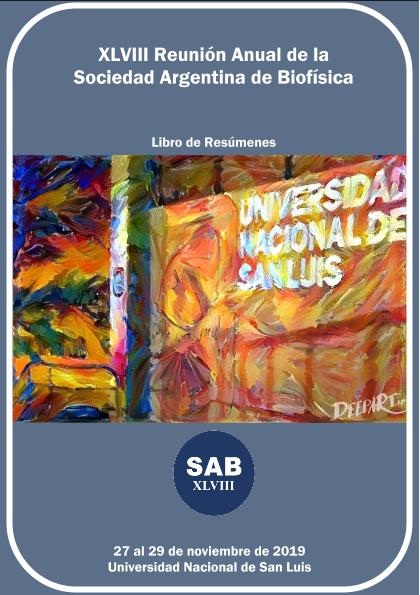Mostrar el registro sencillo del ítem
dc.contributor.author
Peñalva, Daniel Alejandro

dc.contributor.author
Hozbor, Federico Andrés

dc.contributor.author
Aveldaño, Marta Isabel

dc.contributor.author
Antollini, Silvia Susana

dc.contributor.other
Andujar, Sebastian Antonio

dc.date.available
2022-05-12T15:34:38Z
dc.date.issued
2019
dc.identifier.citation
Changes in biophysical properties of membranes containing sphingomyelins with very long chain PUFA during cooling; XLVIII Reunión Anual de la Sociedad Argentina de Biofísica; San Luis; Argentina; 2019; 51-51
dc.identifier.uri
http://hdl.handle.net/11336/157367
dc.description.abstract
Although the molecular changes that affect the spermatozoa of economically important animals, such as bull and ram, are of great research interest, changes regarding plasma membrane lipid organization as temperature decreases are still poorly understood. Gametes from these mammals contain sphingomyelin (SM) species very long chain n-3 polyunsaturated fatty acids (VLCPUFA). (e.g., 30:6 SM, 32:6 SM and 34:6 SM in ram), while in most mammalian cells SM typically contains saturated and monounsaturated acyl chains (C14 to C24). Also, these spermatozoa have three subclasses of choline glycerophospholipids (CGP) with docosahexaenoic acid (22:6n-3) ester-bound at the sn-2 position of glycerol, the sn-1 position being occupied by a C16 hydrophobic chain bound by an ester, ether o vinyl ether linkage. The aim of this study was to gain information about the supramolecular structural organization of these atypical lipids and their changes in the segregation, topological and thermodynamic coexistence during cooling. After isolation of these SM species and CGP subclasses from ram sperm by a combination of chromatographic techniques, large and giant unilamellar vesicles (LUVs and GUVs) were prepared and examined by fluorescence spectroscopy and microscopy. Whereas the 3 subclasses of CGP remained in the liquid crystalline state, the SM species 30:6 SM, 32:6 SM and 34:6 SM showed gel-liquid crystalline transition temperatures within the 40 °C - 5 °C range (5, 15 y 29 °C, respectively). In ternary PC:Cholesterol:SM systems, 32:6 SM and 34:6 SM showed propensity to promote cholesterol-SM domain formation during cooling, although at different temperatures and rates from those of 16:0 SM, here used as a positive control. In GUVs containing 32:6 SM, the lateral lipid segregation and the process of dye efflux started at comparable temperatures. This coincidence did not occur in GUVs containing 16:0 SM. Thus, whereas at physiological temperatures VLCPUFA containing SM molecular species are in a fluid state and are not involved in cholesterol rich domains, this state is deeply altered at the low temperatures at which these gametes are usually preserved, thereby affecting their membrane stability.
dc.format
application/pdf
dc.language.iso
eng
dc.publisher
Sociedad Argentina de Biofísica
dc.rights
info:eu-repo/semantics/openAccess
dc.rights.uri
https://creativecommons.org/licenses/by-nc-sa/2.5/ar/
dc.subject
sperm
dc.subject
cholesterol
dc.subject
sphingomyelin
dc.subject
GUVs
dc.subject.classification
Biofísica

dc.subject.classification
Ciencias Biológicas

dc.subject.classification
CIENCIAS NATURALES Y EXACTAS

dc.title
Changes in biophysical properties of membranes containing sphingomyelins with very long chain PUFA during cooling
dc.type
info:eu-repo/semantics/publishedVersion
dc.type
info:eu-repo/semantics/conferenceObject
dc.type
info:ar-repo/semantics/documento de conferencia
dc.date.updated
2022-04-21T17:55:41Z
dc.journal.pagination
51-51
dc.journal.pais
Argentina

dc.journal.ciudad
Buenos Aires
dc.description.fil
Fil: Peñalva, Daniel Alejandro. Consejo Nacional de Investigaciones Científicas y Técnicas. Centro Científico Tecnológico Conicet - Bahía Blanca. Instituto de Investigaciones Bioquímicas de Bahía Blanca. Universidad Nacional del Sur. Instituto de Investigaciones Bioquímicas de Bahía Blanca; Argentina
dc.description.fil
Fil: Hozbor, Federico Andrés. Instituto Nacional de Tecnología Agropecuaria; Argentina
dc.description.fil
Fil: Aveldaño, Marta Isabel. Consejo Nacional de Investigaciones Científicas y Técnicas. Centro Científico Tecnológico Conicet - Bahía Blanca. Instituto de Investigaciones Bioquímicas de Bahía Blanca. Universidad Nacional del Sur. Instituto de Investigaciones Bioquímicas de Bahía Blanca; Argentina
dc.description.fil
Fil: Antollini, Silvia Susana. Consejo Nacional de Investigaciones Científicas y Técnicas. Centro Científico Tecnológico Conicet - Bahía Blanca. Instituto de Investigaciones Bioquímicas de Bahía Blanca. Universidad Nacional del Sur. Instituto de Investigaciones Bioquímicas de Bahía Blanca; Argentina
dc.relation.alternativeid
info:eu-repo/semantics/altIdentifier/url/https://biofisica.org.ar/reuniones-cientificas/reunionsab-previas/
dc.conicet.rol
Autor

dc.conicet.rol
Autor

dc.conicet.rol
Autor

dc.conicet.rol
Autor

dc.coverage
Nacional
dc.type.subtype
Reunión
dc.description.nombreEvento
XLVIII Reunión Anual de la Sociedad Argentina de Biofísica
dc.date.evento
2019-11-27
dc.description.ciudadEvento
San Luis
dc.description.paisEvento
Argentina

dc.type.publicacion
Book
dc.description.institucionOrganizadora
Sociedad Argentina de Biofísica
dc.description.institucionOrganizadora
Universidad Nacional de San Luis
dc.source.libro
Libro de Resúmenes: XLVIII Reunión Anual de la Sociedad Argentina de Biofísica
dc.date.eventoHasta
2019-11-29
dc.type
Reunión
Archivos asociados
